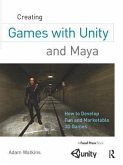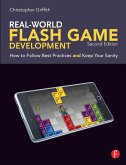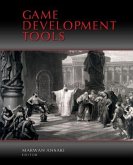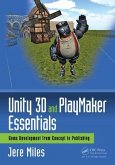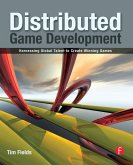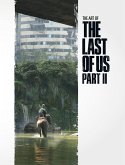Versandkostenfrei innerhalb Deutschlands
53,99 €
inkl. MwSt.
Versandkostenfrei*
Erscheint vorauss. 15. August 2027
Melden Sie sich
hier
hier
für den Produktalarm an, um über die Verfügbarkeit des Produkts informiert zu werden.
oder sofort lesen als eBook

27 °P sammeln
- Broschiertes Buch
Creating Games with Unity and Maya 2nd edition provides you with an end-to-end solution for Unity game development with Maya. This book takes you step-by-step through the process of developing an entire game from scratch - including coding, art, production and deployment. This accessible guide provides a "non-programmer" entry point to the world of game creation. Aspiring developers with little or no coding experience will learn character development in Maya, scripts, GUI interface, and first-and-their person interactions. Also included is access to a powerful website, www.creating3dgames.com…mehr
Andere Kunden interessierten sich auch für
![Creating Games with Unity and Maya Creating Games with Unity and Maya]() Adam WatkinsCreating Games with Unity and Maya68,99 €
Adam WatkinsCreating Games with Unity and Maya68,99 €![Creating Games with Unity and Maya Creating Games with Unity and Maya]() Adam WatkinsCreating Games with Unity and Maya155,99 €
Adam WatkinsCreating Games with Unity and Maya155,99 €![Real-World Flash Game Development Real-World Flash Game Development]() Christopher GriffithReal-World Flash Game Development67,99 €
Christopher GriffithReal-World Flash Game Development67,99 €![Game Development Tools Game Development Tools]() Marwan AnsariGame Development Tools68,99 €
Marwan AnsariGame Development Tools68,99 €![Unity 3D and Playmaker Essentials Unity 3D and Playmaker Essentials]() Jere MilesUnity 3D and Playmaker Essentials77,99 €
Jere MilesUnity 3D and Playmaker Essentials77,99 €![Distributed Game Development Distributed Game Development]() Tim FieldsDistributed Game Development27,99 €
Tim FieldsDistributed Game Development27,99 €![The Art of the Last of Us 02 The Art of the Last of Us 02]() Naughty DogThe Art of the Last of Us 0239,99 €
Naughty DogThe Art of the Last of Us 0239,99 €-
-
-
Creating Games with Unity and Maya 2nd edition provides you with an end-to-end solution for Unity game development with Maya. This book takes you step-by-step through the process of developing an entire game from scratch - including coding, art, production and deployment. This accessible guide provides a "non-programmer" entry point to the world of game creation. Aspiring developers with little or no coding experience will learn character development in Maya, scripts, GUI interface, and first-and-their person interactions. Also included is access to a powerful website, www.creating3dgames.com with completed tutorial files and all source code from the book.
Produktdetails
- Produktdetails
- Verlag: Taylor & Francis
- 2nd ed.
- Seitenzahl: 528
- Erscheinungstermin: 15. August 2027
- Englisch
- Abmessung: 234mm x 156mm
- ISBN-13: 9781498797443
- ISBN-10: 149879744X
- Artikelnr.: 48522552
- Herstellerkennzeichnung
- Libri GmbH
- Europaallee 1
- 36244 Bad Hersfeld
- gpsr@libri.de
- Verlag: Taylor & Francis
- 2nd ed.
- Seitenzahl: 528
- Erscheinungstermin: 15. August 2027
- Englisch
- Abmessung: 234mm x 156mm
- ISBN-13: 9781498797443
- ISBN-10: 149879744X
- Artikelnr.: 48522552
- Herstellerkennzeichnung
- Libri GmbH
- Europaallee 1
- 36244 Bad Hersfeld
- gpsr@libri.de
Jere Miles is the lead instructor of Game Development at Wilkes Community College. He is also the owner of an independent game development company, Dark Glass Studio. He has been creating games since first learning BASIC on an Atari 800 back in the early 1980s.
Introduction. Game Production Process. Scenography. Scenography UV Layout
within the Game Design Pipeline. Textures, Materials and Shaders. Asset
Creation: Unity Scenography Importing. Asset Creation: Unity Scenography
Creation Tools. Baking. Asset Creation: Maya Character Creation. Asset
Creation: Maya Character UV Mapping and Texturing. Asset Creation: Maya
Rigging and Skinning and Unity Animated Character Importing and
Implementation. Unity Sound. Introduction to Unity Scripting Basics and
Graphical User Interface. Unity Triggers. Unity Raycasting. Unity Prefabs
and Instantiation. Unity: Creating Inventory Systems. Health Systems,
Winning and Losing the Game. Optimization.
within the Game Design Pipeline. Textures, Materials and Shaders. Asset
Creation: Unity Scenography Importing. Asset Creation: Unity Scenography
Creation Tools. Baking. Asset Creation: Maya Character Creation. Asset
Creation: Maya Character UV Mapping and Texturing. Asset Creation: Maya
Rigging and Skinning and Unity Animated Character Importing and
Implementation. Unity Sound. Introduction to Unity Scripting Basics and
Graphical User Interface. Unity Triggers. Unity Raycasting. Unity Prefabs
and Instantiation. Unity: Creating Inventory Systems. Health Systems,
Winning and Losing the Game. Optimization.
Preface
Introduction
Why this book?
Who's it for, and how to use it?
Hobbyist strategies
Game Developer usage
Teacher
Student
Structure
Maya, then Unity
Reasoning
Book Paradigm
Assumptions
What we won't be covering
Artist Approach vs Programmer/Engineer Approach
This book is based upon artist approach
Chapter 1 - Game Production Process
Game Production Team Members (or roles)
All roles can be done by one person
Game Production Pipeline in Unity
Conceptualization
Audience
Theme
Conceptualization Artwork
Art Assets Creation
Models
Textures
Animation
Lighting
Game Mechanics
Scripting Team
Game Play
Physics
Varia
What needs to be done when
Flexibility of Unity's approach
What parts aren't so flexible.
How this book mimics the Game Production Process
Introduction to The Game we will be producing in the book.
Chapter 2 - Asset Creation: Maya Scenography Modeling
Scenography Mdeling within the Game Desing Pipeling
So Why Maya Tutorials?
A Bit of 3D Theory
Rendering
Video Cards
Limitation and Optimization for Games
Rules of 3D Game Modeling
Polycount Matters
Topology is Critical
On to the Tools
Tutorial 2.1 Game Level Modeling : The Entryway
Homework and Challenges
Chapter 3 - Asset Creation: Maya Scenography UV Mapping
Scenography UV Mapping within the Game Design Pipeline
UVs
Exploring the UV Texture Editor
Tutorial 3.1 Game Level UV Layout: Tools and Techniques
Homework and Challenges
Chapter 4 - Asset Creation: Maya Sceongraphy Texturing
Scenography Texturing within the Game Design Pipleline
Textures, Materials & Shaders
Nature of Effective Textures
Be Square
Power of Two
Seamless Textures
Maya and Unity
Tutorials
Tutorial 4.1 Seamless Tiled Textures
Tutorial 4.2 Non-Tiled Textures and Their Dirt
Chapter 5 - Asset Creation: Unity Scenography Importing
Introduction to Unity Space
Tutorial 5.1 Creating a Unity Project
Tutorial 5.2 Exporting from Maya
Tutorial 5.3 Importing, Tweaking and Placing Scenography Assets into Unity
Chapter 6 - Asset Creation: Unity Scenography Creation Tools
Introduction to Non-Imported Assets in Unity
Tutorial 6.1 Adding, Manipulating and Understanding Water
Tutorial 6.2 Terrain Creation
Tutorial 6.3 Tree Building
Tutorial 6.4 Particle Creation
Chapter 7 - Lighting & Baking
What's the big deal with lighting?
To light in Maya or Unity?
Tutorial 7.1 Lighting Game Level in Unity
Baking, textures and AO
Tutorial 7.2 Baking in Unity
Light maps in Unity
Tutorial 7.3 Using Light maps in Unity
Chapter 8 - Asset Creation: Maya Character Creations
Low Poly character techniques
Topology mastery
Tutorial 3.1 Game Character Modeling
Character UV
Tutorial 3.2 Game Character UV Mapping
Character Textures
Tutorial 3.3 Game Character Texturing
Chapter 9 - Asset Creation: Character Rigging and Animation and Import
Brief discussion of rigging, skinning, and animation in Maya
Tutorial 4.1 Rigging Game Character
Tutorial 4.2 Skinning Game Character
Game Animation Methodology
Tutorial 4.3 Character Idle
Unity & Animation
Tutorial 4.4 Importing Animated Character and Testing
Chapter 10 - Unity Physics
Physics engines. PhysX
Newtonian physics
Unity's use
"Frame miss"
Elements needed for physics calculations
Limitations and overhead
Tutorial 7.1 Booby Traps and Physics in Unity
Ragdoll
Tutorial 7.2 Ragdoll Implementation
Chapter 11 - Unity Script: Syntax
Power and frustration of scripting
Scripting Overview
Syntax Discussion
MonoBehaviour
Commands
Functions
Variables
Inputs
Time
Components
Vectors
Coroutines
Yields
Scripting Cheat Sheets
Tutorial 8.1 Constructing Basic Scripts from Scratch
Chapter 12 - Unity Script: Triggers
What are
Introduction
Why this book?
Who's it for, and how to use it?
Hobbyist strategies
Game Developer usage
Teacher
Student
Structure
Maya, then Unity
Reasoning
Book Paradigm
Assumptions
What we won't be covering
Artist Approach vs Programmer/Engineer Approach
This book is based upon artist approach
Chapter 1 - Game Production Process
Game Production Team Members (or roles)
All roles can be done by one person
Game Production Pipeline in Unity
Conceptualization
Audience
Theme
Conceptualization Artwork
Art Assets Creation
Models
Textures
Animation
Lighting
Game Mechanics
Scripting Team
Game Play
Physics
Varia
What needs to be done when
Flexibility of Unity's approach
What parts aren't so flexible.
How this book mimics the Game Production Process
Introduction to The Game we will be producing in the book.
Chapter 2 - Asset Creation: Maya Scenography Modeling
Scenography Mdeling within the Game Desing Pipeling
So Why Maya Tutorials?
A Bit of 3D Theory
Rendering
Video Cards
Limitation and Optimization for Games
Rules of 3D Game Modeling
Polycount Matters
Topology is Critical
On to the Tools
Tutorial 2.1 Game Level Modeling : The Entryway
Homework and Challenges
Chapter 3 - Asset Creation: Maya Scenography UV Mapping
Scenography UV Mapping within the Game Design Pipeline
UVs
Exploring the UV Texture Editor
Tutorial 3.1 Game Level UV Layout: Tools and Techniques
Homework and Challenges
Chapter 4 - Asset Creation: Maya Sceongraphy Texturing
Scenography Texturing within the Game Design Pipleline
Textures, Materials & Shaders
Nature of Effective Textures
Be Square
Power of Two
Seamless Textures
Maya and Unity
Tutorials
Tutorial 4.1 Seamless Tiled Textures
Tutorial 4.2 Non-Tiled Textures and Their Dirt
Chapter 5 - Asset Creation: Unity Scenography Importing
Introduction to Unity Space
Tutorial 5.1 Creating a Unity Project
Tutorial 5.2 Exporting from Maya
Tutorial 5.3 Importing, Tweaking and Placing Scenography Assets into Unity
Chapter 6 - Asset Creation: Unity Scenography Creation Tools
Introduction to Non-Imported Assets in Unity
Tutorial 6.1 Adding, Manipulating and Understanding Water
Tutorial 6.2 Terrain Creation
Tutorial 6.3 Tree Building
Tutorial 6.4 Particle Creation
Chapter 7 - Lighting & Baking
What's the big deal with lighting?
To light in Maya or Unity?
Tutorial 7.1 Lighting Game Level in Unity
Baking, textures and AO
Tutorial 7.2 Baking in Unity
Light maps in Unity
Tutorial 7.3 Using Light maps in Unity
Chapter 8 - Asset Creation: Maya Character Creations
Low Poly character techniques
Topology mastery
Tutorial 3.1 Game Character Modeling
Character UV
Tutorial 3.2 Game Character UV Mapping
Character Textures
Tutorial 3.3 Game Character Texturing
Chapter 9 - Asset Creation: Character Rigging and Animation and Import
Brief discussion of rigging, skinning, and animation in Maya
Tutorial 4.1 Rigging Game Character
Tutorial 4.2 Skinning Game Character
Game Animation Methodology
Tutorial 4.3 Character Idle
Unity & Animation
Tutorial 4.4 Importing Animated Character and Testing
Chapter 10 - Unity Physics
Physics engines. PhysX
Newtonian physics
Unity's use
"Frame miss"
Elements needed for physics calculations
Limitations and overhead
Tutorial 7.1 Booby Traps and Physics in Unity
Ragdoll
Tutorial 7.2 Ragdoll Implementation
Chapter 11 - Unity Script: Syntax
Power and frustration of scripting
Scripting Overview
Syntax Discussion
MonoBehaviour
Commands
Functions
Variables
Inputs
Time
Components
Vectors
Coroutines
Yields
Scripting Cheat Sheets
Tutorial 8.1 Constructing Basic Scripts from Scratch
Chapter 12 - Unity Script: Triggers
What are
Introduction. Game Production Process. Scenography. Scenography UV Layout
within the Game Design Pipeline. Textures, Materials and Shaders. Asset
Creation: Unity Scenography Importing. Asset Creation: Unity Scenography
Creation Tools. Baking. Asset Creation: Maya Character Creation. Asset
Creation: Maya Character UV Mapping and Texturing. Asset Creation: Maya
Rigging and Skinning and Unity Animated Character Importing and
Implementation. Unity Sound. Introduction to Unity Scripting Basics and
Graphical User Interface. Unity Triggers. Unity Raycasting. Unity Prefabs
and Instantiation. Unity: Creating Inventory Systems. Health Systems,
Winning and Losing the Game. Optimization.
within the Game Design Pipeline. Textures, Materials and Shaders. Asset
Creation: Unity Scenography Importing. Asset Creation: Unity Scenography
Creation Tools. Baking. Asset Creation: Maya Character Creation. Asset
Creation: Maya Character UV Mapping and Texturing. Asset Creation: Maya
Rigging and Skinning and Unity Animated Character Importing and
Implementation. Unity Sound. Introduction to Unity Scripting Basics and
Graphical User Interface. Unity Triggers. Unity Raycasting. Unity Prefabs
and Instantiation. Unity: Creating Inventory Systems. Health Systems,
Winning and Losing the Game. Optimization.
Preface
Introduction
Why this book?
Who's it for, and how to use it?
Hobbyist strategies
Game Developer usage
Teacher
Student
Structure
Maya, then Unity
Reasoning
Book Paradigm
Assumptions
What we won't be covering
Artist Approach vs Programmer/Engineer Approach
This book is based upon artist approach
Chapter 1 - Game Production Process
Game Production Team Members (or roles)
All roles can be done by one person
Game Production Pipeline in Unity
Conceptualization
Audience
Theme
Conceptualization Artwork
Art Assets Creation
Models
Textures
Animation
Lighting
Game Mechanics
Scripting Team
Game Play
Physics
Varia
What needs to be done when
Flexibility of Unity's approach
What parts aren't so flexible.
How this book mimics the Game Production Process
Introduction to The Game we will be producing in the book.
Chapter 2 - Asset Creation: Maya Scenography Modeling
Scenography Mdeling within the Game Desing Pipeling
So Why Maya Tutorials?
A Bit of 3D Theory
Rendering
Video Cards
Limitation and Optimization for Games
Rules of 3D Game Modeling
Polycount Matters
Topology is Critical
On to the Tools
Tutorial 2.1 Game Level Modeling : The Entryway
Homework and Challenges
Chapter 3 - Asset Creation: Maya Scenography UV Mapping
Scenography UV Mapping within the Game Design Pipeline
UVs
Exploring the UV Texture Editor
Tutorial 3.1 Game Level UV Layout: Tools and Techniques
Homework and Challenges
Chapter 4 - Asset Creation: Maya Sceongraphy Texturing
Scenography Texturing within the Game Design Pipleline
Textures, Materials & Shaders
Nature of Effective Textures
Be Square
Power of Two
Seamless Textures
Maya and Unity
Tutorials
Tutorial 4.1 Seamless Tiled Textures
Tutorial 4.2 Non-Tiled Textures and Their Dirt
Chapter 5 - Asset Creation: Unity Scenography Importing
Introduction to Unity Space
Tutorial 5.1 Creating a Unity Project
Tutorial 5.2 Exporting from Maya
Tutorial 5.3 Importing, Tweaking and Placing Scenography Assets into Unity
Chapter 6 - Asset Creation: Unity Scenography Creation Tools
Introduction to Non-Imported Assets in Unity
Tutorial 6.1 Adding, Manipulating and Understanding Water
Tutorial 6.2 Terrain Creation
Tutorial 6.3 Tree Building
Tutorial 6.4 Particle Creation
Chapter 7 - Lighting & Baking
What's the big deal with lighting?
To light in Maya or Unity?
Tutorial 7.1 Lighting Game Level in Unity
Baking, textures and AO
Tutorial 7.2 Baking in Unity
Light maps in Unity
Tutorial 7.3 Using Light maps in Unity
Chapter 8 - Asset Creation: Maya Character Creations
Low Poly character techniques
Topology mastery
Tutorial 3.1 Game Character Modeling
Character UV
Tutorial 3.2 Game Character UV Mapping
Character Textures
Tutorial 3.3 Game Character Texturing
Chapter 9 - Asset Creation: Character Rigging and Animation and Import
Brief discussion of rigging, skinning, and animation in Maya
Tutorial 4.1 Rigging Game Character
Tutorial 4.2 Skinning Game Character
Game Animation Methodology
Tutorial 4.3 Character Idle
Unity & Animation
Tutorial 4.4 Importing Animated Character and Testing
Chapter 10 - Unity Physics
Physics engines. PhysX
Newtonian physics
Unity's use
"Frame miss"
Elements needed for physics calculations
Limitations and overhead
Tutorial 7.1 Booby Traps and Physics in Unity
Ragdoll
Tutorial 7.2 Ragdoll Implementation
Chapter 11 - Unity Script: Syntax
Power and frustration of scripting
Scripting Overview
Syntax Discussion
MonoBehaviour
Commands
Functions
Variables
Inputs
Time
Components
Vectors
Coroutines
Yields
Scripting Cheat Sheets
Tutorial 8.1 Constructing Basic Scripts from Scratch
Chapter 12 - Unity Script: Triggers
What are
Introduction
Why this book?
Who's it for, and how to use it?
Hobbyist strategies
Game Developer usage
Teacher
Student
Structure
Maya, then Unity
Reasoning
Book Paradigm
Assumptions
What we won't be covering
Artist Approach vs Programmer/Engineer Approach
This book is based upon artist approach
Chapter 1 - Game Production Process
Game Production Team Members (or roles)
All roles can be done by one person
Game Production Pipeline in Unity
Conceptualization
Audience
Theme
Conceptualization Artwork
Art Assets Creation
Models
Textures
Animation
Lighting
Game Mechanics
Scripting Team
Game Play
Physics
Varia
What needs to be done when
Flexibility of Unity's approach
What parts aren't so flexible.
How this book mimics the Game Production Process
Introduction to The Game we will be producing in the book.
Chapter 2 - Asset Creation: Maya Scenography Modeling
Scenography Mdeling within the Game Desing Pipeling
So Why Maya Tutorials?
A Bit of 3D Theory
Rendering
Video Cards
Limitation and Optimization for Games
Rules of 3D Game Modeling
Polycount Matters
Topology is Critical
On to the Tools
Tutorial 2.1 Game Level Modeling : The Entryway
Homework and Challenges
Chapter 3 - Asset Creation: Maya Scenography UV Mapping
Scenography UV Mapping within the Game Design Pipeline
UVs
Exploring the UV Texture Editor
Tutorial 3.1 Game Level UV Layout: Tools and Techniques
Homework and Challenges
Chapter 4 - Asset Creation: Maya Sceongraphy Texturing
Scenography Texturing within the Game Design Pipleline
Textures, Materials & Shaders
Nature of Effective Textures
Be Square
Power of Two
Seamless Textures
Maya and Unity
Tutorials
Tutorial 4.1 Seamless Tiled Textures
Tutorial 4.2 Non-Tiled Textures and Their Dirt
Chapter 5 - Asset Creation: Unity Scenography Importing
Introduction to Unity Space
Tutorial 5.1 Creating a Unity Project
Tutorial 5.2 Exporting from Maya
Tutorial 5.3 Importing, Tweaking and Placing Scenography Assets into Unity
Chapter 6 - Asset Creation: Unity Scenography Creation Tools
Introduction to Non-Imported Assets in Unity
Tutorial 6.1 Adding, Manipulating and Understanding Water
Tutorial 6.2 Terrain Creation
Tutorial 6.3 Tree Building
Tutorial 6.4 Particle Creation
Chapter 7 - Lighting & Baking
What's the big deal with lighting?
To light in Maya or Unity?
Tutorial 7.1 Lighting Game Level in Unity
Baking, textures and AO
Tutorial 7.2 Baking in Unity
Light maps in Unity
Tutorial 7.3 Using Light maps in Unity
Chapter 8 - Asset Creation: Maya Character Creations
Low Poly character techniques
Topology mastery
Tutorial 3.1 Game Character Modeling
Character UV
Tutorial 3.2 Game Character UV Mapping
Character Textures
Tutorial 3.3 Game Character Texturing
Chapter 9 - Asset Creation: Character Rigging and Animation and Import
Brief discussion of rigging, skinning, and animation in Maya
Tutorial 4.1 Rigging Game Character
Tutorial 4.2 Skinning Game Character
Game Animation Methodology
Tutorial 4.3 Character Idle
Unity & Animation
Tutorial 4.4 Importing Animated Character and Testing
Chapter 10 - Unity Physics
Physics engines. PhysX
Newtonian physics
Unity's use
"Frame miss"
Elements needed for physics calculations
Limitations and overhead
Tutorial 7.1 Booby Traps and Physics in Unity
Ragdoll
Tutorial 7.2 Ragdoll Implementation
Chapter 11 - Unity Script: Syntax
Power and frustration of scripting
Scripting Overview
Syntax Discussion
MonoBehaviour
Commands
Functions
Variables
Inputs
Time
Components
Vectors
Coroutines
Yields
Scripting Cheat Sheets
Tutorial 8.1 Constructing Basic Scripts from Scratch
Chapter 12 - Unity Script: Triggers
What are


